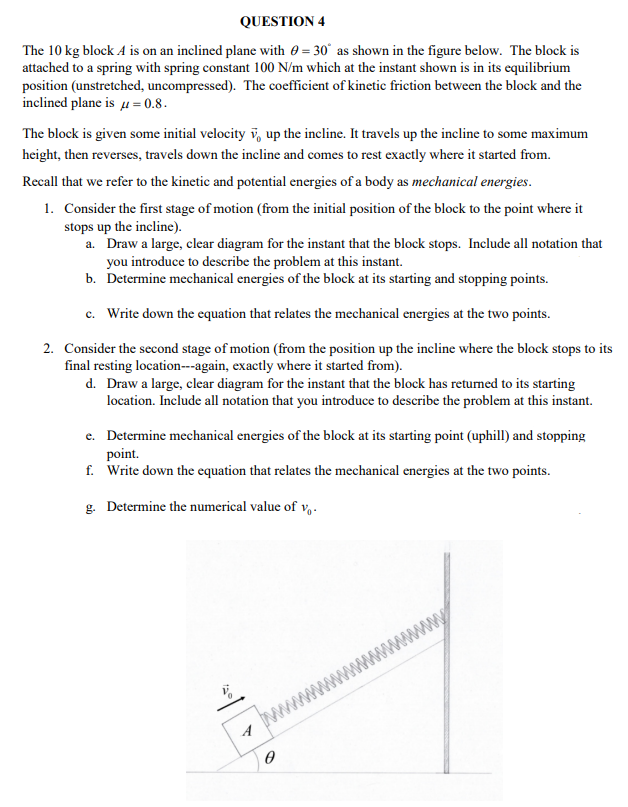The 10 kg block A is on an inclined plane with 0 = 30° as shown in the figure below. The block is attached to a spring with spring constant 100 N/m which at the instant shown is in its equilibrium position (unstretched, uncompressed). The coefficient of kinetic friction between the block and the inclined plane is u = 0.8 - The block is given some initial velocity v, up the incline. It travels up the incline to some maximum height, then reverses, travels down the incline and comes to rest exactly where it started from. Recall that we refer to the kinetic and potential energies of a body as mechanical energies. 1. Consider the first stage of motion (from the initial position of the block to the point where it stops up the incline). a. Draw a large, clear diagram for the instant that the block stops. Include all notation that you introduce to describe the problem at this instant. b. Determine mechanical energies of the block at its starting and stopping points. c. Write down the equation that relates the mechanical energies at the two points. 2. Consider the second stage of motion (from the position up the incline where the block stops to its final resting location--again, exactly where it started from). d. Draw a large, clear diagram for the instant that the block has retumed to its starting location. Include all notation that you introduce to describe the problem at this instant. e. Determine mechanical energies of the block at its starting point (uphill) and stopping point. f. Write down the equation that relates the mechanical energies at the two points. g. Determine the numerical value of v,. www
The 10 kg block A is on an inclined plane with 0 = 30° as shown in the figure below. The block is attached to a spring with spring constant 100 N/m which at the instant shown is in its equilibrium position (unstretched, uncompressed). The coefficient of kinetic friction between the block and the inclined plane is u = 0.8 - The block is given some initial velocity v, up the incline. It travels up the incline to some maximum height, then reverses, travels down the incline and comes to rest exactly where it started from. Recall that we refer to the kinetic and potential energies of a body as mechanical energies. 1. Consider the first stage of motion (from the initial position of the block to the point where it stops up the incline). a. Draw a large, clear diagram for the instant that the block stops. Include all notation that you introduce to describe the problem at this instant. b. Determine mechanical energies of the block at its starting and stopping points. c. Write down the equation that relates the mechanical energies at the two points. 2. Consider the second stage of motion (from the position up the incline where the block stops to its final resting location--again, exactly where it started from). d. Draw a large, clear diagram for the instant that the block has retumed to its starting location. Include all notation that you introduce to describe the problem at this instant. e. Determine mechanical energies of the block at its starting point (uphill) and stopping point. f. Write down the equation that relates the mechanical energies at the two points. g. Determine the numerical value of v,. www
International Edition---engineering Mechanics: Statics, 4th Edition
4th Edition
ISBN:9781305501607
Author:Andrew Pytel And Jaan Kiusalaas
Publisher:Andrew Pytel And Jaan Kiusalaas
Chapter7: Dry Friction
Section: Chapter Questions
Problem 7.79P: The coefficient of rolling resistance between the 30-kg lawn roller and the ground is r=0.1. (a)...
Related questions
Question
Please help i really beg you

Transcribed Image Text:QUESTION 4
The 10 kg block A is on an inclined plane with 0 = 30° as shown in the figure below. The block is
attached to a spring with spring constant 100 N/m which at the instant shown is in its equilibrium
position (unstretched, uncompressed). The coefficient of kinetic friction between the block and the
inclined plane is u= 0.8.
The block is given some initial velocity v, up the incline. It travels up the incline to some maximum
height, then reverses, travels down the incline and comes to rest exactly where it started from.
Recall that we refer to the kinetic and potential energies of a body as mechanical energies.
1. Consider the first stage of motion (from the initial position of the block to the point where it
stops up the incline).
a. Draw a large, clear diagram for the instant that the block stops. Include all notation that
you introduce to describe the problem at this instant.
b. Determine mechanical energies of the block at its starting and stopping points.
c. Write down the equation that relates the mechanical energies at the two points.
2. Consider the second stage of motion (from the position up the incline where the block stops to its
final resting location---again, exactly where it started from).
d. Draw a large, clear diagram for the instant that the block has retumed to its starting
location. Include all notation that you introduce to describe the problem at this instant.
e. Determine mechanical energies of the block at its starting point (uphill) and stopping
point.
f. Write down the equation that relates the mechanical energies at the two points.
g. Determine the numerical value of v,-
www
Expert Solution
Step by step
Solved in 9 steps with 12 images

Knowledge Booster
Learn more about
Need a deep-dive on the concept behind this application? Look no further. Learn more about this topic, mechanical-engineering and related others by exploring similar questions and additional content below.Recommended textbooks for you

International Edition---engineering Mechanics: St…
Mechanical Engineering
ISBN:
9781305501607
Author:
Andrew Pytel And Jaan Kiusalaas
Publisher:
CENGAGE L

International Edition---engineering Mechanics: St…
Mechanical Engineering
ISBN:
9781305501607
Author:
Andrew Pytel And Jaan Kiusalaas
Publisher:
CENGAGE L